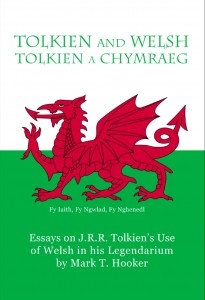 As any good Middle-earthling knows, The Lord of the Rings was primarily a linguistic playground for Tolkien, whose created languages captured the imaginations of readers and movie-goers. For those who’d like a deeper look into the specific influence of Welsh on the languages of Middle-earth, a new book from linguist Mark T. Hooker offers several essays on this very subject, promising ever so enticingly that readers can “learn the Welsh stories behind Gwynfa, Goldberry, Lithe, Took, Boffin, Anduin, and Baranduin.” Tolkien and Welsh (Tolkien a Chymraeg): Essays on J.R.R. Tolkien’s Use of Welsh in his Legendarium is now available on both sides of the pond, offering non-linguists an accessible look at a rare topic. See below for the full press release.
As any good Middle-earthling knows, The Lord of the Rings was primarily a linguistic playground for Tolkien, whose created languages captured the imaginations of readers and movie-goers. For those who’d like a deeper look into the specific influence of Welsh on the languages of Middle-earth, a new book from linguist Mark T. Hooker offers several essays on this very subject, promising ever so enticingly that readers can “learn the Welsh stories behind Gwynfa, Goldberry, Lithe, Took, Boffin, Anduin, and Baranduin.” Tolkien and Welsh (Tolkien a Chymraeg): Essays on J.R.R. Tolkien’s Use of Welsh in his Legendarium is now available on both sides of the pond, offering non-linguists an accessible look at a rare topic. See below for the full press release.
An important new study details how the Welsh language inspired the imagination behind The Lord of the Rings saga.
Mark T. Hooker of Indiana University has studied how author J.R.R .Tolkien applied his knowledge of Welsh language and literature to his epic creation. Tolkien’s lifelong interest in Welsh began in childhood when he saw Welsh words on coal trucks arriving from Wales.In a 1955 lecture entitled “English and Welsh,” Tolkien commented that the names and places in The Lord of the Ringswere primarily developed “on patterns deliberately modeled” on Welsh, and that the Welsh components of his tale, concludes Tolkien, are what have “given perhaps more pleasure to more readers than anything else in it.”In his book British Goblins (1881), Sikes remarks that although Thomas Keightley took Shakespeare to task in his Fairy Mythology (1850) for the inaccuracy of his use of “English fairy superstitions,” no such thing could be said of the Bard’s use of Welsh folklore. Shakespeare’s knowledge and use of Welsh fairy motifs and lore, notes Sikes, were “extensive and peculiarly faithful.” The same can be said of Tolkien.Tolkien’s fascination with the language and history of the West of Britain is demonstrated in his heavily annotated personal copies of The Mabinogion, now held in the English Faculty Library in Oxford. Hooker’s new book demonstrates just how much of an influence this was.Tolkien explained that his creative process was an idiosyncratic enterprise undertaken to satisfy his own private linguistic taste. It begins with a word that develops into a story. He was, therefore, not surprised that most analyses of his work went awry because “linguistic invention” is a “comparatively rare” art form, and most analysts have little understanding “of how a philologist would go about it.” Their analyses “appear to be unauthentic embroideries on my work,” said Tolkien, “throwing light only on the state of mind of [their] contrivers, not on me or on my actual intention and procedure.” (L.380)What makes this book different from other books about Tolkien is that its author is a linguist who shares Tolkien’s appreciation of the histories of words and names, and who plays at the same kind of linguistic invention himself. It is a linguistic perspective that begins with a name or a word, and looks for its story in the real world with which Tolkien was familiar.Learn the Welsh stories behind Gwynfa, Goldberry, Lithe, Took, Boffin, Anduin, and Baranduin.Tolkien and Welsh is available simultaneously in the USA and in the UK. It supplements, rather than competes with, the excellent Tolkien and Wales by Carl Phelpstead.



Pingback: The Warriors Go Geek - Show Notes and Download |